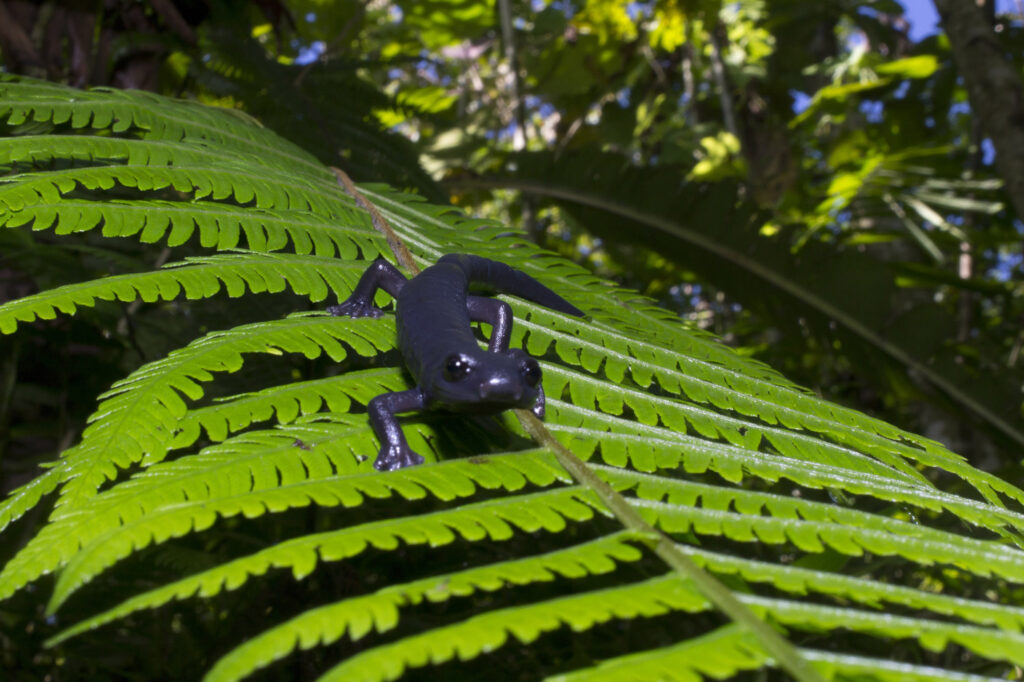New Salamander Species With Black Eyes And Purple Skin Is Already Endangered Due To Deforestation
A group of university students have discovered a new species of salamander with black eyes and purple skin in northern Guatemala and have instantly warned the new species is likely to be classified as endangered due to deforestation.
The salamander species has been named ‘Bolitoglossa qeqom’ (‘Mushroom language’ in Greek and Mayan) and was found during an Ecological Evaluation in the natural reserve Pamac II, in the mountains of the municipality of San Cristobal Verapaz, in the northern Guatemalan department of Alta Verapaz, around 120 kilometres (74,5 miles) from the capital city Guatemala in June 2018.
Daniel Ariano, researcher and professor at the University of Valle of Guatemala, told Real Press in an exclusive interview: “The Bolitoglossa genus comes from the Greek Boletus and glossa, which means mushroom language, due to the form of mushroom on the tongue of this kind of salamander.”
He also explained that the second name, qeqom, comes from the word “q’eqom”, which means ‘dark’ in the Mayan Poqomchi language, which relates not only to the dark colour of the animal but the pitch-black nights of the forest where it lives.
Kennedy Ruiz, a researcher at the University of Valle of Guatemala, told Real Press: “It was a rainy afternoon and we were waiting for nightfall so that we could start the search.”
He went on: “When the night fell, we started the search for amphibians and reptiles, and not long after we started searching we found a black big salamander on a fallen leaf.”

He added: “We not only found the one specimen but we also located several other individuals of the same species.
“After carrying out molecular, morphological and biogeographical analysis, we were able to confirm that those individuals belonged to a new species previously not known to science.”
Hellen Dahinten, a researcher at the same university, told Real Press that the process of identifying a new species is not straightforward.
She explained: “There were characteristics that were different to the rest of the known species, such as the length of the paws, the head size and a place called intercostal space.”
She also commented that genetic analysis confirmed that its genetic code was very different to the rest of the salamanders known in the region.
Margarita Alonso, a researcher at the same university, gave more details about the physical characteristics of the salamander.
She said: “It has very big purple-black eyes. The colour is quite even except for the nose which has a pinkish tint. The articulations also have a pink colour which is revealed under direct light.”

She added: “You can see small grey coffee-like dots in most part of the body but they are gathered in the neck area so it looks like a lighter area.”
Regarding its body, Alonso detailed: “Its hands and feet have a light grey colour, almost translucent. It is between 10 and 15 centimetres long which is considered big for a salamander.”
Jose Cruz, a researcher at the university, said that the diet of the salamander is still not entirely clear.
He explained that generally, salamanders have an insect-based diet, primarily eating “ants, beetles and crickets.”
He added that the continued research into the species is critical to “help improve the preservation strategies in place and develop future captive breeding programs if necessary.”
Despite the fact it is a new species, the researchers warned that it is seriously endangered due to the degradation and destruction of its habitat and deforestation.

Isabela Rosito, another researcher at the University of Valle said: “Salamanders are one of the more sensitive species when it comes to changes and destruction to their environments.”
She explained: “Their special biology which makes them adept in both aquatic and land habitats along with their physical characteristics make them sensitive to all kind of direct perturbation, like the change of the soil, or the temperature and humidity extreme changes”.
Rosito added: “The species could be threatened by the destruction or manipulation of their habitat brought on by deforestation and pesticide used in the nearby crops, as well as the rain patterns caused by climate change.”
The researcher also explained that the species is very sensitive to infection and pathogenic diseases, like diseases linked to fungus.
The researchers said that the new species of salamander is living in a natural reservoir with a lot of animals, such as Pharomachrus, which is the national bird of Guatemala.
Cruz added that the area is also full of pumas, ocelots, endemic birds and “probably more species still to be discovered in that isolated mountains of Guatemala”.

Marcelo Serrano, a researcher at the university, said: “It [the Salamander] lives near a river in a forest with constant rains, which is in very good state of preservation and has a lot of Orquideas and an endemic tree, among other things.”
Dahinten commented that it is important to keep on working to preserve the area and to ensure “the restoration of the ecosystem of the degraded parts of the forest, as well as working towards biosecurity so that the spread of pathogens that threaten wild species can be avoided.”
Guatemala has around 2,300 endangered flora and fauna species and it is considered as one of the most biodiversity countries In the world, but according to experts, it is in danger of losing this status in the next 10 years.
Daniel Ariano, a researcher and professor at the university, said: “Habitat loss is the main threat, due to the increased use of land for agriculture, wildfires and climate change.”
He added: “The trafficking of wild flora and fauna along with the lack of regulation and protection being provided to the forest by the state is also contributing to the rapid environmental degradation.”



